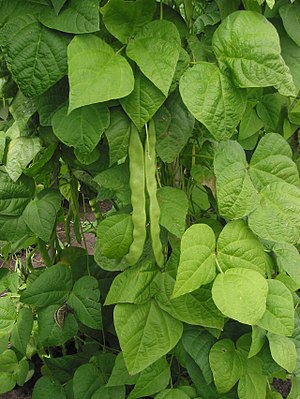Note: This is a project under development. The articles on this wiki are just being initiated and broadly incomplete. You can Help creating new pages.
Phaseolus vulgaris
Phaseolus vulgaris is also known as the common bean, It is a herbaceous annual plant grown worldwide for its edible dry seeds or unripe fruit.
Uses
Parts Used
Chemical Composition
The chemical composition of 12 varieties of beans (Phaseolus vulgaris) was determined. Varieties most commonly found on Brazilian markets were chosen for this work. The average moisture content was 11%, ash 3.5%, fat 1%, protein 25%, starch 40%, crude fiber 4% and pentonsans 7%. etc.[1]
Common names
| Language | Common name |
|---|---|
| Kannada | |
| Hindi | |
| Malayalam | |
| Tamil | |
| Telugu | |
| Marathi | NA |
| Gujarathi | NA |
| Punjabi | NA |
| Kashmiri | NA |
| Sanskrit | |
| English |
Properties
Reference: Dravya - Substance, Rasa - Taste, Guna - Qualities, Veerya - Potency, Vipaka - Post-digesion effect, Karma - Pharmacological activity, Prabhava - Therepeutics.
Dravya
Rasa
Guna
Veerya
Vipaka
Karma
Prabhava
Habit
Identification
Leaf
| Kind | Shape | Feature |
|---|---|---|
| Simple | Round in outline | 1.5-5.0 cm long and as broad, heart-shaped at base, hairless or sparsely hairy, 3-5-lobed, middle lobes broadly ovate or rhombic-ovate |
Flower
| Type | Size | Color and composition | Stamen | More information |
|---|---|---|---|---|
| Bisexual | Broadly ovate-heart-shaped | Cream white | 2.5-3.0 cm across, stalked. Male flowers are solitary, on 1.5 cm long flower-cluster-stalk, bearing near the tip a stalkless |
Fruit
| Type | Size | Mass | Appearance | Seeds | More information |
|---|---|---|---|---|---|
| Simple Fruit | Ovoid | 2-7 cm long, 1-2.5 cm broad | Orange-red | {{{6}}} |
Other features
List of Ayurvedic medicine in which the herb is used
Where to get the saplings
Mode of Propagation
How to plant/cultivate
Phaseolus vulgaris is native to the tropics of the Americas, where it is usually found at elevations above 600 metres, though good crops can be obtained down to sea level.[3]
Commonly seen growing in areas
Photo Gallery
References
- ↑ Chemical composition
- ↑ [ Morphology]
- ↑ Cultivation Details
External Links
- Ayurvedic Herbs known to be helpful to treat Diabetes
- Ayurvedic Herbs known to be helpful to treat Weight loss
- Ayurvedic Herbs known to be helpful to treat Obesity
- Herbs with Fruits used in medicine
- Herbs with Leaves used in medicine
- Habit - Herbs
- Index of Plants which can be propagated by Seeds
- Herbs that are commonly seen in the region of Lowland forest
- Herbs
